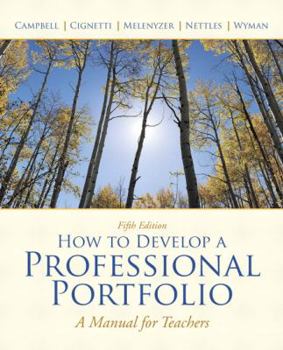How to Develop a Professional Portfolio: A Manual for Teachers
Select Format
Select Condition 
Book Overview
Fifteen years in the marketplace, How to Develop a Professional Portfolio: A Manual for Teachers, by Dorothy M. Campbell, Beverly J. Melenzyer, Diane H. Nettles, Richard M. Wyman, Jr., has grown to be... This description may be from another edition of this product.
Format:Paperback
Language:English
ISBN:0137034547
ISBN13:9780137034543
Release Date:January 2010
Publisher:Pearson Education
Length:101 Pages
Weight:0.55 lbs.
Dimensions:0.3" x 7.3" x 9.1"
Customer Reviews
5 ratings
Great Resource
Published by Thriftbooks.com User , 17 years ago
I bought this book for a college course I was taking. It turns out that this is an excellent resource for any teacher trying to impress employers with an electronic portfolio. I would recommend this book to any teacher looking to secure work and display techno savvy!
Great Book
Published by Thriftbooks.com User , 17 years ago
This is a great book. It is very easy to read and understand. It is very helpful in creating a portfolio.
An invaluable resource for novice teachers
Published by Thriftbooks.com User , 20 years ago
The collaborative effort of Dorothy M. Campbell, Pamela Bondi Cignetti, Beverly J. Melenzyer, Diane H. Nettles, and Richard M. Wyman Jr., and now in an updated third edition, How To Develop A Professional Portfolio: A Manual For Teachers is a "user friendly" guide to creating an classroom educator's portfolio - "an organized, goal-driven documentation of your professional growth and achieved competence in the complex act called teaching" - for use in interviews and the furtherance of a career in teaching. Individual chapters cogently address the organization and format of portfolios; the option of an electronic portfolio; the full potential of portfolios in the ongoing process of one's career, and more. How To Develop A Professional Portfolio is an invaluable resource for novice teachers seeking their first professional assignment, as well as experienced educators seeking advancement, or having to re-establishing themselves professionally after downsizes, transfers, promotions, resettlement, or re-entry into teaching after a period of absence from the field.
Pricey but essential
Published by Thriftbooks.com User , 23 years ago
Yes, I see the price. I know its thinner than the average pad of paper, but you want this. Trust me. Well if you are studying to be a teacher you want this. Assuming that the person looking at this page is probably looking for a good deal on this twenty three dollar eighty page book (does it qualify as a book?) because their prof has assigned it--please, think past the price. This is a book I picked up when I started my program and didn't look at again until I was nearing the end, and at that point began seriously regretting not giving the book some attention all the way through. Portfolios don't have to be that hard, and this book gives you some clear cut SOLID example for what you can do for each standard. The great thing is, if you do read through this book and keep an eye on your growing portfolio while you are in college, you'll find there are all sorts of things--mostly the papers you write in all those classes that you can use here. What's even better is this will help keep you focused on developing your own skills as a teacher in both qualitative and quantitative ways instead of just going into it with no idea of where the road leads.Lastly, I find that a lot of books for educators are not the greatest thing in the world. This tiny handbook IS. This is like one of those little pocket bibles or tao te ching's or something. Take it with you wherever you go and consult it as new situations arise!
A "must read" for developing professional portfolios!
Published by Thriftbooks.com User , 25 years ago
HOW TO DEVELOP A PROFESSIONAL PORTFOLIO A MANUAL FOR TEACHERS is an excellent resource for teacher educators, as well as for aspiring teachers and teachers in the field. The book provides complete, easy-to-understand information for assembling both "working" and "presentation" portfolios. The "working" portfolio is a collection of teaching materials and educational documents that represents professional growth and goal setting both for the veteran teacher and the pre-service teacher. The "presentation" portfolio is a condensed version of the "working" portfolio that documents professional competencies. It is compiled for a specific purpose, such as applying for a job. The chapter "Organization of Portfolios around Teaching Standards" presents a good model for portfolio organization, furnishing information that can be adapted to a particular state or university set of standards. Examples are pertinent; they are based upon standards from professional associations and the National Board for Professional Teaching. The structure, the well-written descriptions, and the examples in the chapter offer a clear and concise introduction to the topic of portfolio organization."Artifacts Possibilities" is another chapter that offers valuable information. The list and description of artifacts is extensive, providing a helpful guide. The "Artifacts Checklist" in Appendix B furnishes an easy-to-reference format that the student or teacher can utilize.The book is a valuable reference. Not only does it include definitions and descriptions of portfolio components, but also displays relevant examples. The listing of professional organizations and the "Artifacts Checklist" in the appendices are good additions. The book is a "quick read" with 84 pages -- 84 pages filled with good ideas and applications that are based upon current educational practices.




